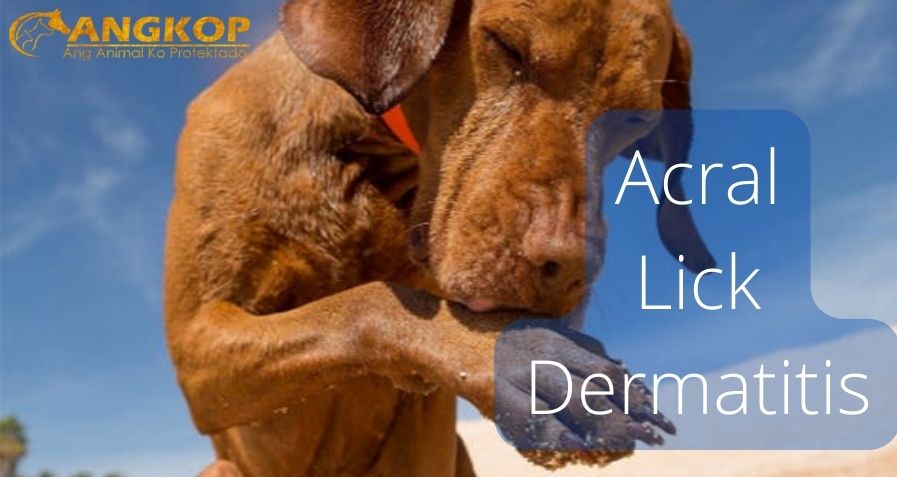Acral Lick Dermatitis

Issues
Acral Lick Dermatitis
- Chronic lesions are directly caused by self-trauma.
- A cycle of licking, pruritus, and secondary infection develops.
SYSTEMS AFFECTED
Skin/Exocrine
SIGNALMENT
Dogs.
- Most common in large breeds—especially Doberman pinschers, Labrador retrievers, Great Danes, Irish and English setters, golden retrievers, Akitas, Dalmatians, boxers, Shar-Peis, and Weimaraners.
- Age at the onset—varies (especially with cause).
- No sex predilection.
SIGNS
- Excessive licking of the affected area.
- Alopecic, eroded, thickened, and raised firm plaques with scabs and exudation, usually located on the dorsal aspect of the carpus, metacarpus, tarsus, or metatarsus.
- Lesions often occur singly or may be multiple.
CAUSES & RISK FACTORS
- Focal trauma to the area initiates a lick-itch cycle.
- Anything causing a local irritation or lesion may initiate response.
- Associated diseases—staphylococcal furunculosis, hypersensitivity, endocrinopathy, demodicosis, dermatophytosis, foreign body reaction, neoplasia, underlying joint disease or arthritis, trauma, neuropathy, psychogenic, or sensory nerve dysfunction.
DIAGNOSIS
DIFFERENTIAL DIAGNOSIS
- Neoplasia
- Bacterial furunculosis
- Focal demodicosis
- Focal dermatophytosis
CBC/BIOCHEMISTRY/URINALYSIS
Normal except in cases of endocrinopathy.
OTHER LABORATORY TESTS
Endocrinopathy—free T4/TSH; ACTH stimulation test or LDDST.
IMAGING
Radiology—neoplasia; local trauma; radiopaque foreign bodies; bony proliferation may be seen secondary to the chronic irritation; evidence of underlying arthritis if over a joint.
DIAGNOSTIC PROCEDURES
- Skin scrapings—demodicosis.
- Dermatophyte culture—fungal infection.
- Epidermal cytology—bacterial infection.
- Bacterial culture and sensitivity—tissue cultures may differ from surface culture.
- Food-elimination diet—determine food allergy.
- Intradermal allergy testing—atopy.
- Biopsy—to rule out neoplasia, other infections.
- Behavioral history.
- Neurologic and orthopedic evaluation.
PATHOLOGIC FINDINGS
Histopathology—epidermal hyperplasia, plasmacytic dermal inflammation, folliculitis, furunculosis, perihidradenitis, hidradenitis, and vertical streaking fibrosis.
TREATMENT
Behavioral therapy: attempt to identify psychological causes and remediate.
Physical restraints—Elizabethan collars and bandaging permit healing.
Therapeutic laser—one controlled study did not demonstrate efficacy.
Diet—no modification unless food hypersensitivity is suspected.
Difficult to treat, especially if no underlying cause is found; warn owner that patience and time are necessary.
Surgery (laser or standard)—may cause increased licking and attention to a larger affected area; if underlying causes are not addressed, recurrence is likely.
FOLLOW-UP
Monitor level of licking and chewing closely.
Treat underlying disease to prevent recurrence.
If no underlying disease is detected, suspect psychogenic causes (compulsive or self-mutilation disorder); prognosis is guarded.
MISCELLANEOUS
AGE-RELATED FACTORS
Dogs < 5 years old—strongly consider allergy
ZOONOTIC POTENTIAL
- Transmitted to humans only if dermatophytosis is the underlying cause; exceedingly rare.
- Methicillin resistant Staphylococcus aureus may have zoonotic implications.
ABBREVIATIONS
ACTH = adrenocorticotropin hormone
LDDST = low-dose dexamethasone suppression test
SSRI = selective serotonin reuptake inhibitor
TCA = tricyclic antidepressant
TSH = thyroid stimulating hormone
Visit your veterinarian as early recognition, diagnosis, and treatment are essential.
You may also visit – https://www.facebook.com/angkopparasahayop
